The Scottish Health Survey 2021 - volume 1: main report
Presents results for the Scottish Health Survey 2021, providing information on the health and factors relating to health of people living in Scotland.
This document is part of 2 collections
Chapter 7 Smoking
Chapter Summary
Smoking rates have declined steadily since 20031, with 11% of adults identifying as current smokers in 2021.
- 12% Men
- 11% Women
The mean number of cigarettes smoked per day by current smokers did not differ significantly by sex in 2021.
- 10.5 among all adults who smoked
- 10.8 among men who smoked
- 10.1 among women who smoked
Smoking prevalence was highest among those aged 45-54 and lowest among those aged 75+.
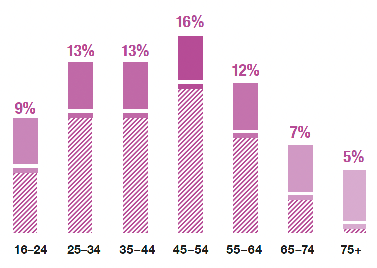
Two thirds of adults had never smoked or used to smoke only occasionally and almost one in four adults identified as ex-regular smokers.
- 11% Current smoker
- 23% Ex-regular smoker
- 66% Never smoked or used to smoke only occasionally
The prevalence of ex-regular smokers significantly increased with age.
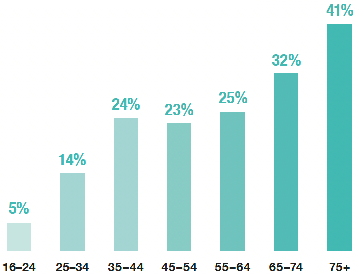
As in previous years, adults living in the most deprived areas in 2021 were more likely to be current cigarette smokers.
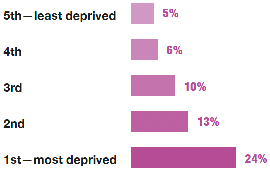
Exposure of adult non-smokers to second-hand smoke has reduced between 2003 and 2021.
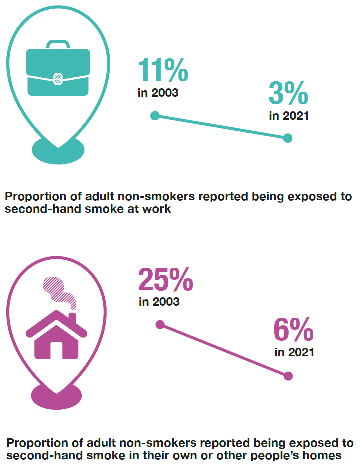
Over four fifths of non-smokers in 2021 reported not being exposed to second-hand smoke in any public place, at work, in someone's home or in a car.
- 82% of adults
In 2021, the proportion of children living in accommodation in which someone regularly smoked indoors was significantly lower than in previous years.

In 2021, the proportion of children exposed to second-hand smoke in their own home was also significantly lower than in previous years.
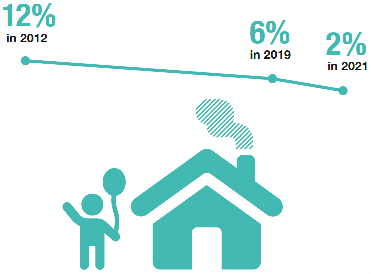
Current e-cigarette use, in 2021, declined after staying constant each year between 2015 and 2019.
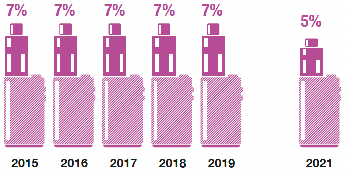
In 2021:
- 16% of all adults had ever used e-cigarettes, of which
- 11% had previously used e-cigarettes
- 5% were current e-cigarette users
Prevalence of current e-cigarette use, in 2021, was highest among those aged 25-34 and lowest among those 75 and over.

1 While it is clear that the prevalence of cigarette smoking has been falling since 2003, the size of the drop between 2019 and 2021 should be treated with caution, due to the change in the method of data collection. With falling rates of smoking, an increase in the number of ex-smokers might be expected, but this is not the case.
Smoking
Stephen Rule
7.1 Introduction
Tobacco is recognised internationally as a major public health threat. More than eight million deaths each year worldwide are a direct result of tobacco use, with over one million attributed to second-hand smoke exposure. The production of tobacco is also destructive to the environment, with wide reaching health impacts.[1],[2]
Smoking is the cause of around one in five deaths and the primary preventable cause of premature death and ill health in Scotland.[3],[4] While overall smoking rates have declined in Scotland, differences by deprivation have increased, with rates highest in the most deprived areas highlighting that smoking remains an ongoing health inequality challenge.[5]
Smoking-related health risks increase as smokers continue to smoke but can be substantially reduced following cessation. Smoking cessation interventions such as nicotine replacement therapy are cost-effective interventions that help to reduce the costs associated with treatment for smoking related illnesses and conditions.[6]
7.1.1 Policy background
The overall strategic objective for health in the Scottish Government's National Outcomes Framework is 'We are healthy and active'.[7] Scottish Health Survey data is used as a National Indicator to measure the proportion of adults with two or more of the following health risk behaviours: currently smoking, harmful drinking, low physical activity and obesity.[8] Protecting Scotland, Renewing Scotland: The Government's Programme for Scotland 2020-21[9] reaffirmed the government's commitment to the action plan outlined in Raising Scotland's Tobacco-free Generation published in June 2018.[10] The action plan outlines interventions and policies that aim to ensure Scotland is raising a tobacco-free generation by 2034 (defined as 'a smoking prevalence among the adult population of 5% or lower').
A Fairer, Greener Scotland: Programme for Government 2021-22[11] pledged to develop a new action plan which will identify further interventions needed in order to achieve the ambition for a tobacco‑free generation by 2034.
7.1.2 Reporting on smoking in the Scottish Health Survey
This chapter presents prevalence of adult cigarette smoking and e-cigarette use for 2021 as well as trends in prevalence of cigarette smoking. Exposure to second-hand smoke among children and adult non-smokers is also reported.
It should be noted that, due to the change in the method of data collection in 2021, caution is advised in the interpretation in changes to the smoking data recorded in 2021. More detail can be found in Chapter 1 of the Scottish Health Survey 2021 volume 2: technical report.
The area deprivation data are presented in Scottish Index of Multiple Deprivation (SIMD) quintiles. To ensure that the comparisons presented are not confounded by the different age profiles of the quintiles, the data have been age-standardised. For a detailed description of both SIMD and age-standardisation as well as definitions of other terminology used in this chapter and for further details on the data collection methods for smoking, please refer to Chapter 2 of the Scottish Health Survey 2021- volume 2: technical report.
Supplementary tables on smoking are also published on the Scottish Government website: Scottish Health Survey.
7.1.3 Comparability with other UK statistics
The Health Survey for England, Health Survey for Northern Ireland and the National Survey for Wales provide estimates of smoking prevalence in the other home nations within the UK. The surveys are conducted separately and have different sampling methodologies, so smoking prevalence estimates across the surveys are only partially comparable. Smoking prevalence estimates from the UK-wide Integrated Household Survey for Scotland, Wales, England and Northern Ireland have been deemed to be fully comparable.[12]
7.2 Smoking
7.2.1 Cigarette smoking status, 2003-2021, by sex
The proportion of adults who reported themselves to be current smokers in 2021 was 11%. This represents a substantial decline since 2019, just prior to the COVID-19 pandemic, when the proportion was 17%. Prior to that, smoking rates had been decreasing, from 28% in 2003.
The magnitude of the decline was similar among men and women. In 2021, the proportion of women who were current smokers was 11%, while that of men was 12% (16% and 19% respectively in 2019). The downward trend has been tracked since 2003 when 28% of women and 29% of men were current smokers.
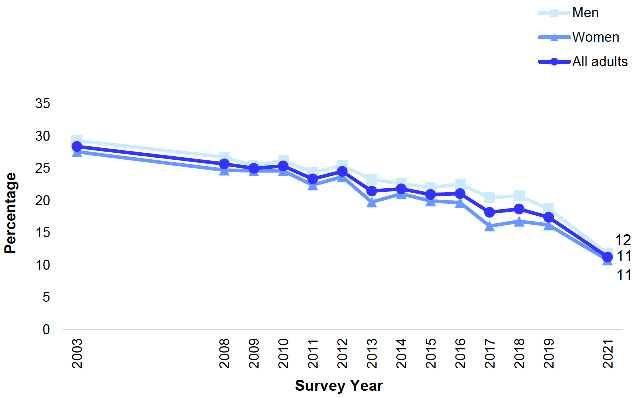
While it is clear that the prevalence of cigarette smoking has been falling since 2003, the size of the drop between 2019 and 2021 should be treated with caution, due to the change in the method of data collection (see Technical Report). With falling rates of smoking, an increase in the number of ex-smokers might be expected, but this is not the case. The proportion of adults who indicated that they used to smoke cigarettes regularly, but no longer do so, was 23% in 2021 (women 23%, men 24%). This has shown only a small amount of variation since 2003, ranging between 22% and 26%, with a slightly lower range for women (20% to 24%) than for men (22% to 28%).
In 2021, two thirds (66%) of adults reported never having smoked or previously having smoked cigarettes only occasionally (women 67%, men 64%). The proportion for all adults is considerably higher than in 2019 (59%).
Current smokers were smoking an average of 10.5 cigarettes per day in 2021 (women 10.1; men 10.8). This represents a continued decline since the mean of 12.2 cigarettes per day in 2019 (women 11.3, men 13.1) and the mean of 15.3 cigarettes per day in 2003 (women 14.7; men 15.9). Figures 7A and 7B, Table 7.1
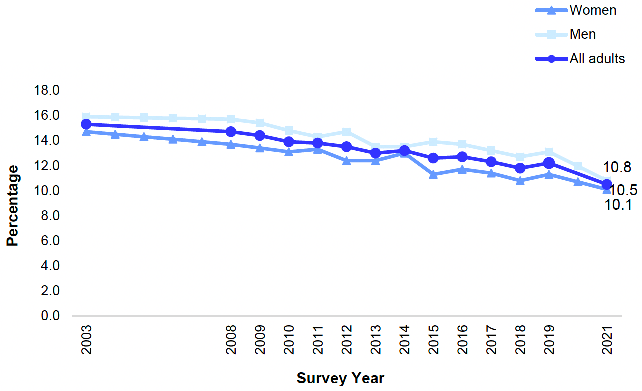
7.2.2 Cigarette smoking status (age-standardised), 2003 to 2021, by area deprivation and sex
In 2021, the age-standardised prevalence of current smoking status continued to be higher among adults living in more deprived areas than among those living in less deprived areas (24% and 5% respectively). While significant decreases in smoking prevalence were recorded in 2021 for all but the least deprived areas, the overall pattern has held since 2003, when 45% of those who lived in the most deprived areas were current regular smokers compared with 17% in the least deprived areas.
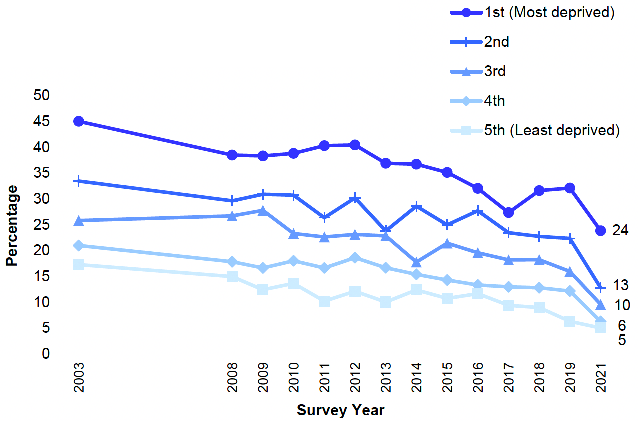
In 2021, the age-standardised mean number of cigarettes smoked per day did not differ significantly between current smokers who lived in the most deprived areas (10.8 cigarettes) and those who lived in the least deprived areas (9.7 cigarettes), unlike in 2019 when the mean number of cigarettes was significantly higher for current smokers living in the most deprived areas compared with those living in the least deprived (13.1 and 10.3 cigarettes respectively). Figure 7C, Table 7.2
7.2.3 Cigarette smoking status, 2021, by age and sex
As in previous years,[13] differences in smoking prevalence by age were recorded in 2021, although with fewer significant variations between age groups. Smoking was most prevalent among those aged 45-54 years (16% of both men and women), and least prevalent among those aged 75 and older (5% of both men and women).
Ex-regular smokers tended to be more common among older age groups. In 2021, only 5% of those aged 16-24 reported having smoked regularly in the past, whereas this proportion increased to 41% for those aged 75 years or older. The reverse pattern was seen for the proportion of adults who have never smoked, falling from 85% of those aged 16-24, to 55% of those aged 75 and over. Figure 7D, Table 7.3
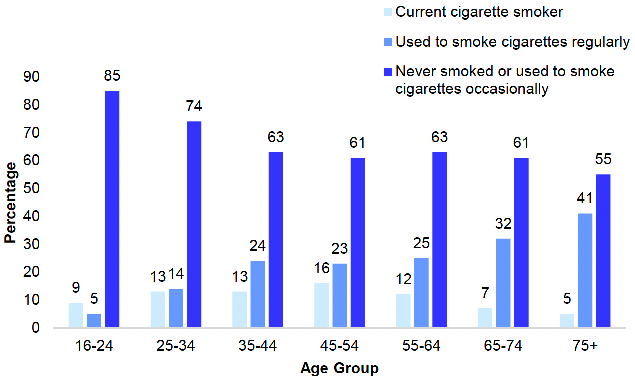
7.2.4 Non-smokers' exposure to second-hand smoke, 2003 to 2021
The proportion of adult non-smokers that reported being exposed to second-hand smoke in their own or another person's home has reduced over the time series, with an overall decrease from 25% in 2003 to 6% in 2021. This pattern was evident for both men (24% in 2003 and 5% in 2021) and women (27% in 2003 and 6% in 2021). Please note that some caution should be exercised when interpreting the extent of the decrease in 2021 (see section 7.1.2 for more detail).
The proportion of adult non-smokers that reported being exposed to second-hand smoke outside of buildings has remained in the range 10% - 15% since 2012 (10% in 2021).
The proportion of adult non-smokers who reported that they were not exposed to second-hand smoke in any of the places included in the SHeS[14] increased to 82% in 2021 from 73% in 2019. Between 2012 to 2019, this proportion had remained between 70% - 74%, with similar patterns for men and women. Table 7.4
7.2.5 Children's exposure to second-hand smoke, 2012 to 2021
In 2021, 4% of children were living in accommodation in which someone regularly smoked indoors; a figure which was consistent for both boys and girls. This is a significant decrease from 2019, when this proportion was 11% and an overall decrease of fifteen percentage points from 2012 (19%). Please note that some caution should be exercised when interpreting the extent of the decrease in 2021 (see section 7.1.2 for more detail).
A small proportion (2%) of children were reported to be exposed to second-hand smoke in their own home in 2021. Over the time series, this has followed a similar pattern to the proportion where there was a smoker in the household. Between 2012 and 2014, 11% - 12% of children were exposed to second-hand smoke in their own home. This proportion decreased to 6% - 7% between 2015 and 2019. This pattern has been similar among boys and girls across the time series. Figure 7E, Table 7.5
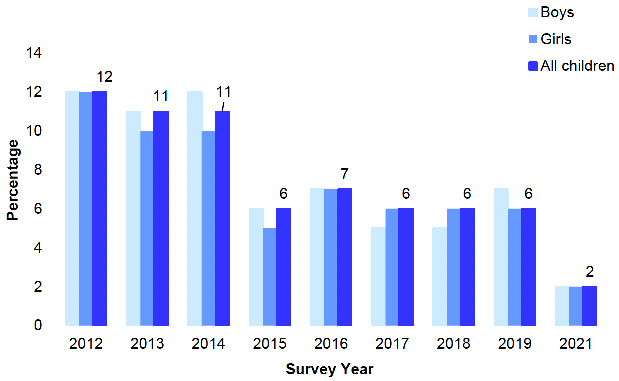
7.2.6 E-cigarette use, 2014 to 2021, by age and sex
In 2021, 16% of all adults reported that they had ever used e-cigarettes: 5% reported being current users and 11% having previously used them. More than four out of five adults (84%) had never used e-cigarettes. Similar patterns were recorded for men and women.
The highest proportion of current e-cigarette users in 2021 was recorded among those aged 25-34 (8%) with the lowest proportions among those aged 75 or older (1%) and those aged 65-74 (2%). The highest proportion of former e-cigarette users was among those aged 16-24 (19%), while the lowest was among those aged 75 years or older (2%).
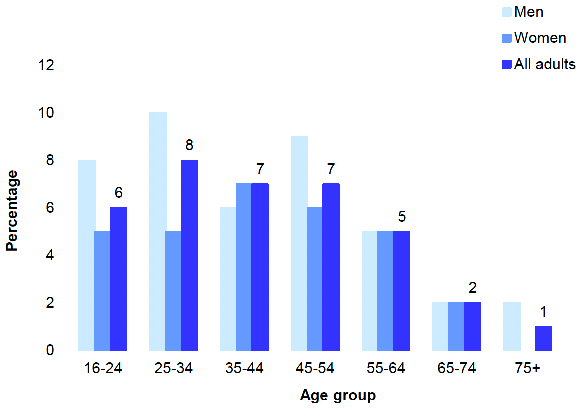
Current e-cigarette use has remained in the range 5% - 7% since 2014, with the 2021 figure at the lower end of this range (5%). The overall pattern of decreasing proportions having ever used e-cigarettes by age continued in 2021, ranging from 25% among those aged 16-24 to 3% among those aged 75 and over, with similar patterns for both men and women.
The proportion of adults that have never used e-cigarettes ranged from 80% to 85% between 2014 and 2021 and has consistently been highest among those aged 75 or over (95% - 98% over this period). Figure 7F, Table 7.6
Table List
Table 7.1 Cigarette smoking status, 2003-2021, by sex
Table 7.2 Cigarette smoking status (age-standardised), 2003 to 2021, by area deprivation and sex
Table 7.3 Cigarette smoking status, 2021, by age and sex
Table 7.4 Non-smokers' exposure to second-hand smoke, 2003 to 2021, by sex
Table 7.5 Children's exposure to second-hand smoke, 2021-2021, by sex
Table 7.6 E-cigarette use, 2014 to 2021, by age and sex
The tables can be found on the main report page under supporting files
References and notes
1. World Health Organisation (2019) Tobacco.
2. See World No Tobacco Day 2022.
3. Raising Scotland's tobacco-free generation: our tobacco control action plan 2018. Edinburgh: Scottish Government, 2018.
4. See Smoking prevention.
5. See Welcoming Scotland’s Tobacco Control Action Plan.
6. A guide to smoking cessation in Scotland. Edinburgh: NHS Scotland, 2017.
7. The National Performance Framework.
8. See National Indicator Performance.
9. Protecting Scotland, Renewing Scotland: The Government's Programme for Scotland 2020- 2021, p. 72 [Online]
10. Raising Scotland's tobacco-free generation: our tobacco control action plan 2018. Edinburgh: Scottish Government, 2018.
11. A Fairer, Greener Scotland: Programme for Government 2021-22.
12. See Comparing smoking prevalence estimates.
13. See for example, Scottish Health Survey 2019 - volume 1: main report.
14. In their own or other people's homes; at work; in cars/vans; outside buildings (e.g. pubs, shops, hospitals), or in other public spaces.
Contact
There is a problem
Thanks for your feedback